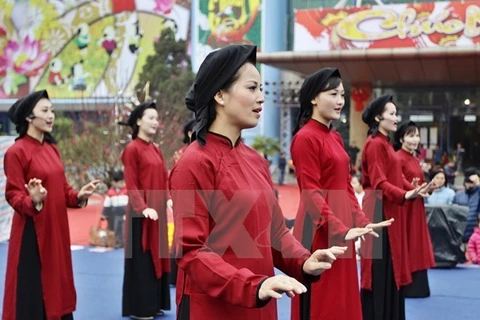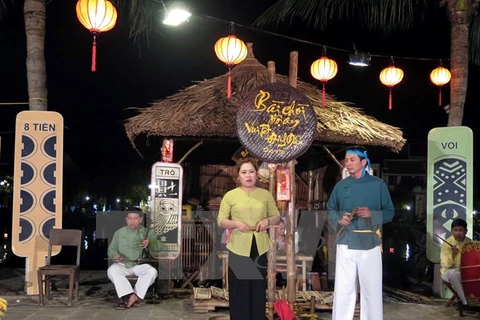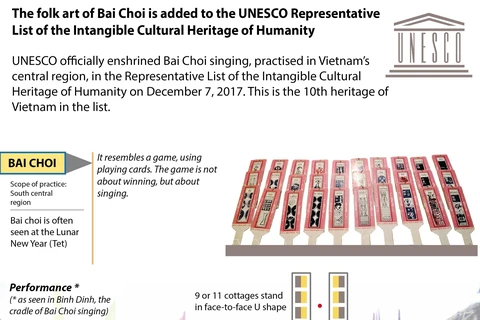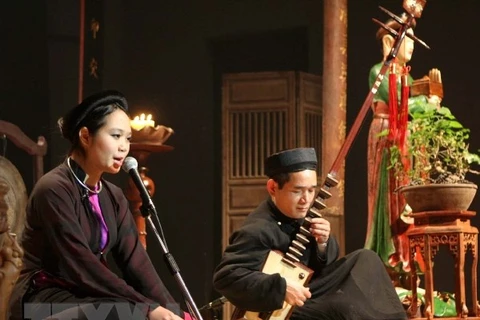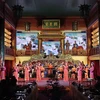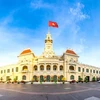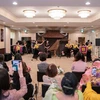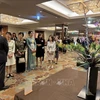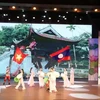 Vietnamese Minister of Culture, Sports and Tourism (R) receives the UNESCO certificate recognising Bai Choi singing as an Intangible Cutural Heritage of Humanity. (Photo: VNA)
Vietnamese Minister of Culture, Sports and Tourism (R) receives the UNESCO certificate recognising Bai Choi singing as an Intangible Cutural Heritage of Humanity. (Photo: VNA) Binh Dinh (VNA) – A ceremony was held in Quy Nhon city, south central province of Binh Dinh, on May 5 to receive a certificate from UNESCO recognising Bai Choi singing, a popular folklore style of singing in central Vietnam, as an Intangible Cultural Heritage of Humanity.
Prime Minister Nguyen Xuan Phuc, Deputy Prime Minister Vu Duc Dam, leaders of ministries, sectors and provinces, and representatives of UNESCO Vietnam attended the ceremony.
The PM expressed his pleasure to be present in Binh Dinh province to share joy of the local people on the occasion, while highlighting the folk music genre practised in Vietnam’s central region which is both entertainment and creativeness as well as connects the community.
With 12 intangible cultural heritage recognised by UNESCO, Vietnam now ranks eight out of 177 member nations of the Convention for the Safeguarding of the Intangible Cultural Heritage, he said.
By recognising Bai Choi singing as an Intangible Cultural Heritage of Humanity by UNESCO, the world community reconfirmed Vietnam’s rich cultural heritage and acknowledged the country’s contributions to further enriching the cultural heritage of humanity.
He called on people to join efforts in maintaining and preserving Bai Choi singing as it is now the common asset of the humanity.
At the ceremony, Minister of Culture, Sports and Tourism Nguyen Ngoc Thien announced the national action programme on protecting and promoting the intangible cultural heritage of Bai Choi singing.
Under the action programme, a series of activities will be implemented to promote and popularise the values of the heritage.
On the occasion, 400 artisans and singers from nine central provinces with Bai Choi singing heritage joined an art performance programme, highlighting the establishment and development of Bai Choi sining.
Earlier, the recognition of Bai Choi singing was made during the 12th session of the UNESCO Inter-governmental Committee for the Safeguarding of the Intangible Cultural Heritage in Jeju, the Republic of Korea (RoK), on December 7.
The folk singing genre is popular in the central provinces of Quang Binh, Quang Tri, Thua Thien-Hue, Quang Nam, Quang Ngai, Binh Dinh, Phu Yen and Khanh Hoa, and Da Nang city.
Bai choi is often seen at local spring festivals and resembles a game, using playing cards and village huts.
The stage for Bai choi performances encompasses nine cottages, each containing five or six ‘players’. One of the cottages, the central house, contains a troupe of musicians and instruments. A deck of playing cards is split in half, with one stack distributed amongst the players, and the other placed in the central house. The cards are stuck onto bamboo poles and erected outside the cottages.
The game singer delivers a flag to each cottage, all the while singing Bai choi, and then draws a card from the central house. Whoever holds the card closest in value to the game singer’s card wins.
The Bai choi songs are about festivals, daily life and work, and are accompanied by musical instruments.
The game and songs were developed by Mandarin Dao Duy Tu (1572-1634) to help locals protect their crops.
According to the Inter-governmental Committee for the Safeguarding of the Intangible Cultural Heritage, Bai Choi is an important cultural activity in Vietnamese villages and communes, meeting the demand for entertainment and arts of the community.
Bai Choi songs are moral lessons, demonstrating patriotism, connectivity in the community and living experience of people.
The Ministry of Culture, Sports and Tourism recognised Bai Choi as national intangible cultural heritage during 2014-2016.
Apart from Bai Choi, the UNESCO Representative List of the Intangible Cultural Heritage of Humanity includes other 11 Vietnamese heritage – the traditional practice of “Tho Mau Tam Phu” (Worship of Mother Goddesses), tug-of-war game, which is also played in Cambodia, the RoK and the Philippines, Nghe Tinh province’s Vi-Giam folk singing, Don ca tai tu (amateur singing in southern Vietnam), Hung King worship ritual, Xoan singing of Phu Tho province, Giong festival and Soc temples in Hanoi, Ca Tru (ceremonial singing), Bac Ninh province’s Quan ho (love duet singing), the space of Gong culture in the Central Highlands and Hue's royal court music.-VNA
VNA
